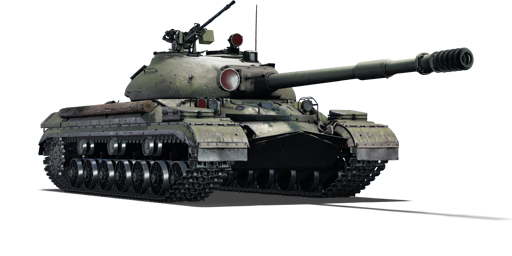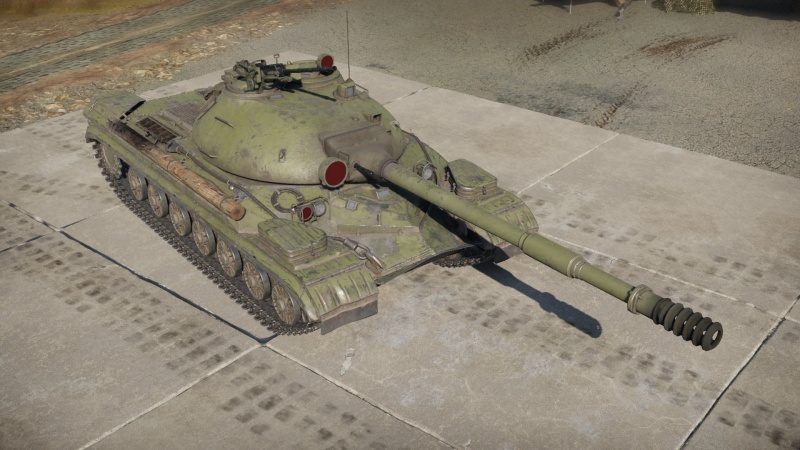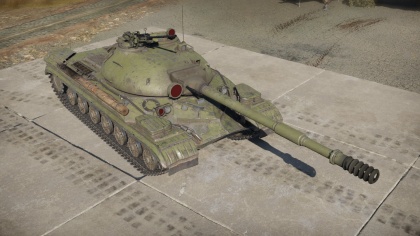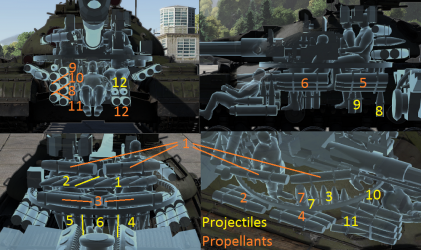T-10M
Contents
Description
The T-10M is a rank VI Soviet heavy tank
with a battle rating of 8.0 (AB) and 8.3 (RB/SB). This heavy tank was introduced in Update 1.51 "Cold Steel".
The T-10 is a Soviet heavy tank from the Cold War that is the last of the IS series. It was originally named the IS-10, but after Iosif Stalin's death in 1953 and the general sentiment surrounding that event, it was renamed to simply T-10. The T-10 was in production between 1953 and 1966, which allowed the Soviet Union to put out just under 1,500 of them.
The T-10 was better than its predecessors in almost every way: firepower, speed, armour and efficiency. It was a very promising breakthrough, that came too late. In the game, the T-10 plays like a medium tank with just below-average mobility, although it can easily reach speeds of up to 40 km/h. Arguably, its only disadvantage is the sluggish reload speed.
However, in the 1960s, the Soviets have realized that the concept of the main battle tank (MBT), was much more efficient. Guns of similar firepower, as well as reasonable armour, could be placed on a medium tank, which would be much more mobile than a heavy tank. That suited the Soviets because MBTs could be used in many more types of operations than the T-10, or a similar tank.
General info
Survivability and armour
From being one of the most feared tanks in the game, the T-10M is now very often overlooked. Its armour is called out-of-date, easily over-matched by new APFSDS rounds even when at an angle.
Frontally, the T-10M's armour ranges from 200 mm (LFP) to 250 mm (peak of the pike) to over 300 mm around the turret. That is not bad, especially for hull-down positions where the T-10M can present only its turret. When compared to the Chieftains (Mk 3 and Mk 5, without composite armour), the T-10M has more hull armour, and even a more evenly protected turret (Chieftains have a weaker side on the left when facing one frontally).
Angling your hull is not effective, it's detrimental. For instance, the stock round on the Leopard A1A1 (DM13, APDS round) cannot penetrate your upper pike or your turret, only the LFP. However, if you present your side, it negated the angling of the pike and allows the Leopard to get through, usually hitting your driver and the ammunition. The story is the same with almost every vehicle - you shouldn't angle.
Lastly, mind that you have 3 crew members sitting in line on your left side when looking from the T-10M, that presents a one-shot opportunity for any opponents that can penetrate your pike. Although, your driver almost always dies, which means that you can't reverse into cover, so try not to get shot.
Armour type:
- Rolled homogeneous armour (Hull, Turret roof)
- Cast homogeneous armour (Turret)
| Armour | Front | Sides | Rear | Roof |
|---|---|---|---|---|
| Hull | 120 mm (57°) Front glacis 120 mm (49°) Lower glacis 40,60 mm (78-79°) Driver's port |
120 mm (50°) Top 80 mm (0-64°) Middle 30 mm (60°) Bottom |
50 mm (53°) Top 60 mm (21°) Bottom |
30 mm |
| Turret | 120-250 mm (26-60°) Turret front 100 + 250 mm (0-75°) Gun mantlet |
130-190 mm (3-55°) | 102 mm (21-47°) | 30 mm |
| Armour | Sides | Roof | ||
| Cupola | 40 mm | 40 mm |
Notes:
- Suspension wheels are 20 mm thick while tracks are 30 mm thick.
- Turret side armour is not equally thick, ranging from 130 mm to 190 mm in some areas.
Mobility
| Game Mode | Max Speed (km/h) | Weight (tons) | Engine power (horsepower) | Power-to-weight ratio (hp/ton) | |||
|---|---|---|---|---|---|---|---|
| Forward | Reverse | Stock | Upgraded | Stock | Upgraded | ||
| Arcade | 54 | 11 | 50 | 968 | 1,431 | 19.36 | 28.62 |
| Realistic | 51 | 10 | 663 | 750 | 13.26 | 15 | |
The T-10M is surprisingly agile. Its top speed of 50 km/h is on par with MBTs; however, it is rarely reached. Its acceleration is great, enabling you to reach strategic locations relatively quickly.
Modifications and economy
Armaments
Main armament
| 122 mm M-62-T2S | |||||
|---|---|---|---|---|---|
| Capacity | Vertical guidance |
Horizontal guidance |
Stabilizer | ||
| 30 | -4°/+15° | ±180° | Two-plane | ||
| Turret rotation speed (°/s) | |||||
| Mode | Stock | Upgraded | Prior + Full crew | Prior + Expert qualif. | Prior + Ace qualif. |
| Arcade | 13.8 | 19.0 | 23.1 | 25.6 | 27.2 |
| Realistic | 10.1 | 11.9 | 14.5 | 16.0 | 17.0 |
| Reloading rate (seconds) | |||||
| Stock | Prior + Full crew | Prior + Expert qualif. | Prior + Ace qualif. | ||
| 20.00 | 17.2 | 15.9 | 15.0 | ||
Ammunition
| Penetration statistics | |||||||
|---|---|---|---|---|---|---|---|
| Ammunition | Type of warhead |
Penetration in mm @ 90° | |||||
| 10m | 100m | 500m | 1000m | 1500m | 2000m | ||
| BR-472 | APCBC | 295 | 292 | 275 | 265 | 239 | 222 |
| OF-472 | HE | 35 | 35 | 35 | 35 | 35 | 35 |
| 3BM-11 | APDS | 361 | 360 | 358 | 353 | 338 | 320 |
| 3BK-9 | HEATFS | 400 | 400 | 400 | 400 | 400 | 400 |
| Shell details | ||||||||||
|---|---|---|---|---|---|---|---|---|---|---|
| Ammunition | Type of warhead |
Velocity in m/s |
Projectile Mass in kg |
Fuse delay
in m: |
Fuse sensitivity
in mm: |
Explosive Mass in g (TNT equivalent): |
Normalization At 30° from horizontal: |
Ricochet: | ||
| 0% | 50% | 100% | ||||||||
| BR-472 | APCBC | 950 | 25 | 1.2 | 19 | 184.8 | +4° | 48° | 63° | 71° |
| OF-472 | HE | 865 | 27 | 0.1 | 0.5 | 3,000 | +0° | 79° | 80° | 81° |
| 3BM-11 | APDS | 1620 | 7.4 | N/A | N/A | N/A | +1.5° | 75° | 78° | 80° |
| 3BK-9 | HEATFS | 920 | 18 | 0.0 | 0.1 | 2,890 | +0° | 65° | 72° | 75° |
Ammo racks
| Full ammo |
Ammo Part |
1st rack empty |
2nd rack empty |
3rd rack empty |
4th rack empty |
5th rack empty |
6th rack empty |
7th rack empty |
8th rack empty |
9th rack empty |
10th rack empty |
11th rack empty |
12th rack empty |
Visual discrepancy |
|---|---|---|---|---|---|---|---|---|---|---|---|---|---|---|
| 30 | Projectiles Propellants |
27 (+3) 27 (+3) |
24 (+6) 24 (+6) |
20 (+10) 20 (+10) |
17 (+13) 17 (+13) |
14 (+16) 14 (+16) |
11 (+19) 11 (+19) |
10 (+20) 10 (+20) |
9 (+21) 9 (+21) |
7 (+23) 7 (+23) |
5 (+25) 5 (+25) |
3 (+27) 3 (+27) |
1 (+29) 1 (+29) |
No |
Machine guns
| 14.5 mm KPVT | ||||||
|---|---|---|---|---|---|---|
| Pintle mount | ||||||
| Capacity (Belt capacity) | Fire rate (shots/minute) |
Vertical guidance |
Horizontal guidance | |||
| 250 (50) | 600 | -5°/+60° | ±180° | |||
| Coaxial mount | ||||||
| Capacity (Belt capacity) | Fire rate (shots/minute) |
Vertical guidance |
Horizontal guidance | |||
| 200 (50) | 600 | N/A | N/A | |||
Usage in battles
The T-10M should be played a MBT; fast and mobile. The armour looks great on paper but going up against APFSDS and ATGMs, it's not able to keep up. Since you will usually be playing against battle rating 8.7 German and Italian tanks (in Realistic Battles), you will be able to penetrate the majority of tanks frontally (for the Maus, aim for the cheeks). Your stock BR-472 round is very capable, and will likely one-shot any tank that it penetrates, which is reassuring since your reload speed is well below average. If you do have trouble penetrating tanks (e.g. you are playing the Chieftains/M60s/etc, or at a range), your next strategy should be to flank. Not a single tank in the game has enough side armour to withstand the BR-472, granting easy one-shot capability.
Modules
| Tier | Mobility | Protection | Firepower | |||
|---|---|---|---|---|---|---|
| I | Tracks | Parts | Horizontal Drive | |||
| II | Suspension | Brake System | FPE | Adjustment of Fire | ||
| III | Filters | Crew Replenishment | Elevation Mechanism | 3BM-11 | Smoke Grenade | |
| IV | Transmission | Engine | ESS | 3BK-9 | NVD | |
Pros and cons
Pros:
- Decent acceleration and top speed for a heavy tank
- Good reverse speed, as with many late Russian heavy tanks
- Stock round has a lot of explosive filler, thus often one shots
- 14.5mm machine guns are effective at deterring strafing aircraft and can shred lightly-armored vehicles.
- Has a two-plane Stabilizer
- Unlockable APDS and HEAT-FS can take on most vehicles frontally
Cons:
- Has ammunition at the rear of the turret; a shell strike there can end your game if you get flanked
- Due to the "pike" of the frontal armour, angling is not a good idea, especially against enemies with HEAT or Sabot rounds
- Armour has a hard time dealing with modern ammo types and ATGMs
- Stock round will struggle against a lot of enemies from the front due to its lack of penetration
- The unlockable APDS and HEAT-FS shells has minimal spalling effects, must aim for ammo or important crew members such as the gunner
- Slow turret rotation speed when stock and not spaded
History
Development
The desire for the successor of the IS-3 heavy tank with a more lenient weight and cost requirement brought forth a start in development in 1948. The tank labelled the IS-8, used many characteristics from the previous experimental heavy tanks, with the engine of the IS-4 and IS-6, road wheels and tracks of the IS-4, the turret traverse mechanism and suspension system from the IS-7. The IS-8 also used an improved 122 mm gun from the IS-2 and IS-3 models. The armour on the IS-8 and IS-3 were quite similar in format but was thickened on the IS-8 for improved protection. The hull was extended to make room for an engine cooling system, necessitating another road wheelset on the suspension. The IS-8 was deemed ready for production between late 1950 to early 1951, with production to begin at the Chelyabinsk Tractor Plant (ChTZ), with reports that some IS-8 tanks were also produced at a tank plant in Omsk as well.[1]
Stalin's death in 1953 brought forth a political situation of De-Stalinization to eradicate the influence of the late Soviet leader. Due to this, the IS-8 heavy tanks that take its first two letters from the name of Joseph (Iosef) Stalin was renamed to the T-10. Production of the tank continued, but with implemented improvements. The T-10A model introduced a newer 122 mm D-25TS gun with a vertical stabilization system and a bore evacuator, with a rammer implemented inside the tank to ease with the loading process by helping the loaders push the rounds into the breech. The T-10's sole telescopic sight was replaced with two new sights, one periscopic and one telescopic. There was also a night-vision device and gyrocompass installed for the gunner. The next upgrade was the T-10B in the mid-1950s, which introduced a two-axis stabilization for the gun and new fire control sight inside with little changes outside. The final revision was with the T-10M in 1957, with the most notable difference being the new M-62-TS gun, which was longer than its previous iterations and presents a very unique multi-slotted muzzle brake and bore evacuator along with having a stabilization system. DShK heavy machine guns were also replaced with the newer KPVT machine guns, which benefited by being similar in ballistic characteristics with the M-62-TS gun to double as a range-finder. Another change in the T-10M was the improved 750 hp engine. The last reported change to the T-10 design was in the 1960s when the tanks went through a rebuild with a new transmission and main clutch.[1]
By the time the T-10's production ended in 1962, a total of 8,000 of all types of T-10 heavy tanks had been manufactured, making the T-10 the most numerous Soviet heavy tank produced.[1]
Usage
The T-10s were organized in heavy tank regiments in the same way as the IS-3s. When first introduced, the Soviet heavy tank regiments were a composite unit organized in 1947 that was made of between 44-46 heavy tanks bolstered by 21 heavy assault guns. In between 1958 and 1959, the heavy tank regiments were reorganized to consist of only heavy tanks, 100 IS-3 or T-10 tanks that made the formation quite powerful. These regiments would help make up heavy tank divisions, which would consist of two heavy tank regiments and one medium tank regiment. These heavy tank divisions, intended to drive an offensive operation, were stationed along the borders of the Soviet Union against the Western forces.[1]
The T-10, like the IS-3, was a concern to the Western forces whose only response were the heavy M103 and Conqueror heavy tanks. The T-10 never saw combat against a Western force but was deemed invulnerable in frontal engagements against medium tanks of the time like the M48 Pattons, even when they used HEAT rounds. However, in a contest against the heavy tanks, the M103 and Conqueror presented better fire-control systems and range-finders that would benefit a well-trained and emplaced crew against an offensive force. The contest between the two sides with their heavy tanks reached a disparity with the introduction of newer tanks like the M60 and Chieftain, both which have guns able to penetrate straight through the T-10's front armour at standard ranges.[1]
Decline and discontinuation
Though the T-10 and the Soviet heavy tank family gave a formidable opponent to the Western forces, their fame and glory became short-lived in the 1960s. The new premier of the Soviet Union, Nikita Khrushchev, began cutbacks in the military with a new strategic goal of missiles and nuclear armament rather than with conventional forces. The heavy tanks, considered outdated, was ordered to have their production halted in 1960 by Khrushchev.[1] His orders are not without reason, heavy tanks are difficult to maintain and transport across the huge Soviet Union, which also did not have many bridges that could support a heavy tank. Another reason was the changing anti-tank technology that made tank armour extremely vulnerable, especially against the new anti-tank missiles that are becoming more and more efficient at their task in destroying tanks. Still, the order did not mean the dissolution of heavy tank units as by 1978, there were still up to 2,300 heavy tanks in the Far East. To this day, many heavy tanks are still either in inactive reserves or dug in as pillboxes along the borders of the Soviet Union. The heavy tank's place in the Soviet Union's military was replaced by the main battle tanks (MBT) like the T-64, which presented a much better firepower, armour, and mobility for only a weight of 35 tons, a technological sign on the rising prevalence of the MBT.[1]
In-game description
The T-10M was an upgraded version of the T-10 heavy tank. The new vehicle’s main distinction was the installation of new weaponry. The new M-62-T2S 122mm cannon was installed on the tank. The new gun was significantly more powerful than the previous one and had greater initial projectile speed and improved armor penetration. The cannon was also equipped with a two-plane stabilizer, which allowed the tank’s crew to fire effectively while it was in motion.
A significant increase in the tank’s combat capabilities was also achieved by installing equipment for firing and driving at night. The field of vision provided by the new T-2S-29-14 periscope sight with two-plane stabilizer allowed the gun to be fired accurately both directly and from cover.
The installed TPN-1 night-vision sight also made it possible to fire accurately at night at a range of up to 1,150 meters (3,773 feet). The testing of the new tank was completed in December, 1956, and in September, 1957 the tank was added to the arsenal.
The tank was produced at the Chelyabinsk Kirov Factory and the Leningrad Kirov Factory until 1965. According to published data, 979 vehicles were produced with this modification.
Media
An excellent addition to the article will be video guides, as well as screenshots from the game and photos.
See also
Links to the articles on the War Thunder Wiki that you think will be useful for the reader, for example:
- reference to the series of the vehicles;
- links to approximate analogues of other nations and research trees.
External links
References
| USSR heavy tanks | |
|---|---|
| KV-1 | KV-1 (L-11) · KV-1 (ZiS-5) · KV-1E · KV-1S |
| KV-2 | KV-2 (1939) · KV-2 (1940) · KV-2 (ZiS-6) |
| Other KVs | KV-85 · KV-122 · KV-220 |
| IS-1/2 | IS-1 · IS-2 · IS-2 (1944) · IS-2 No.321 · IS-2 "Revenge" · Object 248 |
| Other IS tanks | IS-3 · IS-4M · IS-6 · IS-7 |
| T-10 | T-10A · T-10M |
| Multi-turreted | T-35 · SMK |
| Other | Object 279 |
| Lend-Lease | ▂MK-II "Matilda" |







